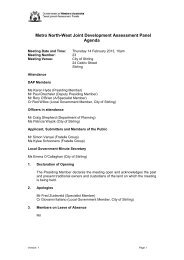Pool and Spa Safety Guidelines - City of Stirling
Pool and Spa Safety Guidelines - City of Stirling
Pool and Spa Safety Guidelines - City of Stirling
Create successful ePaper yourself
Turn your PDF publications into a flip-book with our unique Google optimized e-Paper software.
Location <strong>of</strong> latching device:<br />
Option 1: Gate latches must be at least 1.5m high from<br />
ground level <strong>and</strong> at least 1.4m high above the highest lower<br />
rail or foothold within the gate/fence.<br />
Option 2: Gate latch must be 150mm below the access hole,<br />
or top <strong>of</strong> the gate. If there is an access hole in the gate, the<br />
bottom <strong>of</strong> the access hole must be at least 1200mm high<br />
from the ground <strong>and</strong> 1100mm above the highest lower rail.<br />
Latch must be shielded 450mm in radius from the latch,<br />
under the latch. There must be no gaps in these areas<br />
exceeding 10mm. The gate latch must be on the inside <strong>of</strong> the<br />
fence/gate.<br />
Windows<br />
Opening windows: The lowest opening part <strong>of</strong> the window<br />
must be higher than 1.2m above the internal floor level.<br />
Alternatively, a fixed security screen must be provided or a<br />
fixed device that prevents the window opening more than<br />
100mm must be installed (e.g. a self-tapping screw or a fixed<br />
block for a sliding window, a chain for an awning window).<br />
Keylocks are not suitable for this purpose.<br />
Doors (Pre 5 Nov 2001 only)<br />
Opening doors: All doors must be fitted with a self-closing<br />
<strong>and</strong> self-latching device that will return the door closed<br />
from any position to operate the latching device. The latch<br />
release must not be less than 1.5m above the inside floor<br />
level. Where there are double doors, both doors must selflatch<br />
independently, or one door must be permanently fixed<br />
closed. The doors must be non-climbable <strong>and</strong> <strong>of</strong> sound<br />
material. Nylon or fibreglass flywire (even behind a grill) are<br />
not suitable for pool barrier doors. Sliding doors must not be<br />
able to be lifted out <strong>of</strong> the door track.<br />
Roller doors/garage doors/electric gates: These are<br />
unacceptable <strong>and</strong> do not comply with the Australian<br />
St<strong>and</strong>ard 1926.1.-1993<br />
Other<br />
Temporary Fencing: If a swimming pool barrier is damaged<br />
<strong>and</strong> a swimming pool is exposed temporary fencing is<br />
required. Adequate temporary fencing is described as<br />
non climbable from the ground to the top <strong>of</strong> the fence to a<br />
height <strong>of</strong> 1.2 metres (or a climbable fence over 2.4 metres<br />
high). A non climbable fence can be made non climbable<br />
by wrapping shade cloth around the fence <strong>and</strong> tying it firmly<br />
to the fence with cable ties. Please note this is a temporary<br />
measure only.<br />
Skimmer box lids (optional): Information regarding the<br />
danger <strong>of</strong> old style skimmer boxes can be obtained through<br />
the Department <strong>of</strong> Commerce.<br />
Permanent fixtures: Any barrier that is permanently fixed<br />
in place must be unable to be undone or removed by h<strong>and</strong><br />
or by key. Keylocks <strong>and</strong> padlocks are not acceptable under<br />
any circumstances.<br />
Pet doors: Either the height or width <strong>of</strong> a pet door must be<br />
100mm or less for it to be accepted.<br />
<strong>Safety</strong> Hints<br />
• Nearly all drowning incidents can be attributed to a lack<br />
<strong>of</strong> supervision.<br />
• Supervision means supervising at all times.<br />
• Supervision cannot be done through a window or through<br />
the pages <strong>of</strong> a newspaper.<br />
• If you must go inside, take the child with you – they.<br />
should not be left alone in the pool area at any time!<br />
• Children cannot supervise children – this is the adults<br />
responsibility.<br />
• Maintain your pool barriers at all times.<br />
• Encourage swimming lessons from an early age.<br />
The <strong>City</strong> <strong>of</strong> <strong>Stirling</strong> is required by law to inspect pool <strong>and</strong> spa<br />
barriers for safety. <strong>Pool</strong> Inspectors have a legal right <strong>of</strong> entry<br />
onto your property to conduct these inspections.<br />
MORE INFORMATION<br />
For more information visit the <strong>City</strong> <strong>of</strong> <strong>Stirling</strong> website at<br />
www.stirling.wa.gov.au<br />
If you have been advised by the <strong>City</strong> that an inspection is<br />
required <strong>and</strong> you wish to make an appointment please contact<br />
us on 9205 8555<br />
Visit the Building Commission website for<br />
information on <strong>Pool</strong> <strong>and</strong> <strong>Spa</strong> regulations at<br />
www.buildingcommission.wa.gov.au<br />
Visit the Department <strong>of</strong> Commerce website for legal<br />
rights advice <strong>and</strong> skimmer box information at<br />
www.commerce.wa.gov.au<br />
Sustainability<br />
Water is a precious resource we can all protect. Investing in a<br />
pool cover can be a time <strong>and</strong> money saving way to do this.<br />
Using a pool cover regularly reduces evaporation by 90 to 95<br />
percent. Uncovered swimming pools across the metropolitan<br />
area have the potential to lose over 4 billion litres <strong>of</strong> water a year.<br />
<strong>Pool</strong> covers keep the pool warmer, safer <strong>and</strong> cleaner.<br />
For more information on Being Water Wise visit the Water<br />
Corporation at www.water corporation.com.au<br />
* Please be aware that a pool/spa cover is not an approved<br />
safety barrier <strong>and</strong> will not be accepted as such.<br />
DISCLAIMER<br />
This publication is intended to provide general information only. Verification<br />
with the relevant original Legislation, Local Laws <strong>and</strong> Australian St<strong>and</strong>ards is<br />
advised for a detailed reference.<br />
<strong>Pool</strong> <strong>and</strong> <strong>Spa</strong><br />
<strong>Safety</strong> <strong>Guidelines</strong><br />
<strong>City</strong> <strong>of</strong> <strong>Stirling</strong> 25 Cedric Street <strong>Stirling</strong> WA 6021<br />
Telephone (08) 9205 8555 | Facsimile (08) 9345 8822<br />
www.stirling.wa.gov.au
<strong>Pool</strong> <strong>and</strong> <strong>Spa</strong> <strong>Safety</strong> <strong>Guidelines</strong><br />
Suitable barriers <strong>and</strong> building approval are required for<br />
all pools <strong>and</strong> spas capable <strong>of</strong> containing water to a depth<br />
<strong>of</strong> 300mm or greater. This includes portable spas, inflatable<br />
pools <strong>and</strong> above ground pools.<br />
All pool <strong>and</strong> spa barriers must be compliant with the<br />
Australian St<strong>and</strong>ard 1926.1 (AS1926.1-1993) <strong>and</strong> the Building<br />
Regulations 2012 <strong>and</strong> amendments.<br />
<strong>Pool</strong> or spa applications submitted for approval after<br />
5 November 2001<br />
There must be restricted access to the pool/spa from the<br />
road, neighbouring properties <strong>and</strong> any habitable building<br />
on the property by the use <strong>of</strong> an isolation fence. Doors are<br />
NOT permitted to lead into a pool/spa area <strong>and</strong> there must<br />
be a compliant fence or gate between any door <strong>and</strong> the pool/<br />
spa. Windows are permitted but must be restricted as per<br />
AS1926.1.-1993<br />
<strong>Pool</strong>s or spas installed or granted approval before<br />
5 November 2001<br />
There must be restricted access to the pool/spa from the road,<br />
neighbouring properties, <strong>and</strong> any habitable building on the<br />
property. Isolation fencing is not required if the doors <strong>and</strong><br />
windows <strong>of</strong> any habitable buildings, gates, <strong>and</strong> fences are<br />
compliant with AS1926.1.-1993 Gates must open away from the<br />
pool area.<br />
Design <strong>and</strong> Construction<br />
Fencing<br />
The fence <strong>and</strong> its immediate surrounds are to be designed<br />
to form an effective barrier against child access at any point.<br />
Fencing must be a permanent structure, unable to be removed<br />
or undone by h<strong>and</strong> or key at any point. Fencing must be free<br />
<strong>of</strong> sharp edges, sharp projections <strong>and</strong> similar hazards.<br />
Types <strong>of</strong> materials: Fencing may be constructed <strong>of</strong> any<br />
material, provided it is durable <strong>and</strong> complies to the Australian<br />
St<strong>and</strong>ard 1926.1.-1993<br />
Fencing height: The effective fencing height shall be no less<br />
than 1.2m at any point (measured from the finished ground<br />
level <strong>and</strong> any climbable object outside <strong>of</strong> the fence).<br />
Perforated materials: Openings that are 13mm or less are<br />
deemed unclimbable. If the opening is greater than 13mm but<br />
less than 100mm, the fence must be at least 2.4m in height.<br />
Ground clearance: The space between the finished ground<br />
level <strong>and</strong> the lowest horizontal member <strong>of</strong> the fencing shall<br />
not exceed 100mm <strong>and</strong> the ground must be stable.<br />
Horizontal surfaces (including rods/braces/hinges): Unless<br />
gaps between verticals are 10mm or less, <strong>and</strong> horizontal rails<br />
<strong>of</strong> the fence are inaccessible or on the inside <strong>of</strong> the fence, the<br />
following requirements apply:<br />
• Horizontal surfaces must be at least 900mm apart.<br />
• The highest lower horizontal surface <strong>of</strong> the fence must be<br />
at least 1100mm away from the top <strong>of</strong> the barrier.<br />
Vertical members: <strong>Spa</strong>cing between uprights must not<br />
exceed 100mm. Vertical members must be strong <strong>and</strong> rigid<br />
with very little flexibility.<br />
Indentations <strong>and</strong> projections: Any indentation, projection, or<br />
gap greater than 10mm may be considered climbable. A<br />
wedge or fillet <strong>of</strong> at least 60 degrees to the horizontal can be<br />
fitted to most projections to render it unclimbable, although it<br />
must be flush with the wall/fence behind.<br />
Climbable objects: Horizontal objects located near the inside<br />
<strong>of</strong> the fencing must be at least 300mm away from the fence.<br />
On the outside <strong>of</strong> the fencing there must be no climbable<br />
objects within a radius <strong>of</strong> 1.2m. Bushes, pumps, filters, taps,<br />
<strong>and</strong> meter boxs are examples <strong>of</strong> problem climbable objects.<br />
Dividing/boundary fencing: At least one side <strong>of</strong> a dividing<br />
fence between two properties must be at least 1.2m in height<br />
<strong>and</strong> unclimbable. If this cannot be accomplished on the<br />
neighbour’s side, it must be accomplished on the pool side.<br />
Above ground pools: The walls <strong>of</strong> the pool can be used as the<br />
barrier if they are not less than 1.2m in height <strong>and</strong> have no<br />
climbable projections or indentations. However, a fence <strong>and</strong><br />
gate that complies to the Australian St<strong>and</strong>ard 1926.1 must<br />
be fitted around the ladder <strong>and</strong> filter equipment (if the filter<br />
equipment is closer than 1.2m from the top <strong>of</strong> the pool).<br />
Gates <strong>and</strong> Fittings<br />
Gate construction: Where a pool gate has diagonal<br />
bracing the gaps between the uprights must not exceed<br />
10mm. Where there are double gates, both gates must<br />
self-latch independently or one gate must be permanently<br />
fixed closed.<br />
Direction <strong>of</strong> opening: Gates must open away from the pool area.<br />
Automatic closing device: All gates that access the pool area<br />
must be fitted with a device that will return the gate to the<br />
closed position <strong>and</strong> operate the latching device from all<br />
positions from a stationary start without manual force.<br />
Latching device: Gates must be fitted with a self-latching device<br />
that will automatically operate on the closing <strong>of</strong> the gate <strong>and</strong><br />
will prevent the gate from being re-opened without manually<br />
releasing the mechanism. The gate latch must not be able to<br />
be opened by the insertion <strong>of</strong> an implement particularly from<br />
underneath the latch.<br />
The gate latch must not be capable <strong>of</strong> being unlatched by the<br />
addition <strong>of</strong> manual force (usually downwards) to the gate.

















